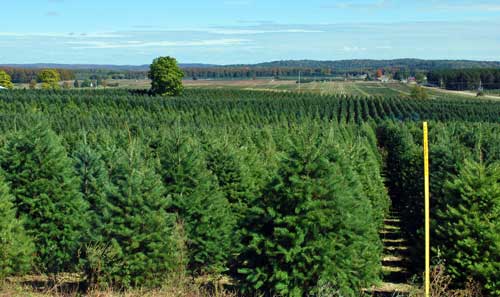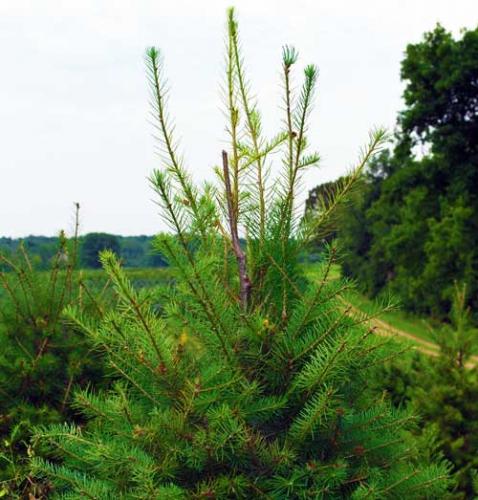Overcoming leader loss from cankers on Douglas fir
How to minimize the financial impacts of loss from cankers on leaders of Douglas fir.
In the related Michigan State University Extension article “Watch for cankers on leaders of Douglas fir this spring,” we discussed the recent swings in winter temperature that can cause bark wounding on leaders, top whorls and sometimes even the trunks of the tree. These wounds allow fungi that are unable to invade healthy bark to gain entry into the tree and become established. Other points of entry can be through short, dead pruning stubs, poorly healed pruning cuts or other injuries that cause wounds to the tree.
Weak pathogens such as Valsa, Cytospora, Leucostuma and Dermea fungi are some of the species that are able to colonize the freeze-damaged tissue and form cankers, causing dead terminals to appear in late spring and throughout summer. Symptoms include dark, sunken cankers that expand along the twig, trunk, leader or limbs and sometimes will produce large amounts of sap and small eruptions in the bark about the size of a pin-head.
Loss of the leader from cankers can reduce the grade of your tree, delay harvest until the leader is replaced or make the tree completely unsalable. Fungicides are not an effective method of controlling these secondary fungi that enter through winter injury or pruning wounds. We have found it is best to manage infection or spread of the disease by avoiding tree stress, utilizing proper pruning techniques and removing and destroying cankered wood.
Avoid stress
Douglas fir is native to a broad geographic area in the western United States and Canada. It is sensitive to cold winter temperature or late spring frost and should not be planted in frost pockets or areas with poor air drainage (Photo 1). We often see more problems with cankers in areas where we have pushed the site limits of this species.

Photo 1. Douglas fir should be planted on high elevation sites with good,
cold air drainage and limited risk of frost damage. Photo credit: Jill O'Donnell, MSUE
Pruning
Make sure to prune Douglas trees early enough (late summer or early fall) to allow the wound to heal. Also, be sure you are correctly making pruning cuts. Leaving a stub or cutting too far into the trunk of the tree will slow healing and invite infection. For fastest healing, prune the leader back to the branch collar, but do not injure the collar itself. Growers may want to consider leaving multiple leaders to choose from in case some are lost to canker (Photo 2).

Photo 2. Leaving multiple leaders can help growers more quickly
overcome leader loss from canker. Photo credit: Jill O'Donnell, MSUE
According to “A New Tree Biology,” written by Alex Shigo, trees will respond to wounding or injury with compartmentalization and the development of barrier zones. When referring to old wounds on a tree, we often use the term “healing” to describe the scar tissue that appears, but the tree is actually sealing the wound by producing callus tissue around the edges of the wound. This new wood growth forms a protective boundary preventing infection or decay from spreading into the new tissue, effectively compartmentalizing the compromised tissue.
Along with the formation of the callus tissue, trees also make the existing wood surrounding the cut unsuitable for spread of the fungal or decay organisms. This process is not completely understood, but it appears that the tree tries to avoid further injury by putting up chemical and physical barriers around the infected cells to confine the damage. These areas of tissue are referred to as barrier zones.
Removing damaged wood
The removal of damaged wood should occur in the spring if possible. To ensure that all the disease is removed, cut several inches below any canker symptoms into healthy tissue. Make sure to check the cut to ensure that all the disease has been removed. Incomplete removal of the canker wastes time, money and is little to no benefit in disease management. Make sure to remove cankered wood from the plantation and burn or bury infected materials.
Come learn how to identify and monitor for the most destructive pests and diseases of Michigan’s deciduous and conifer tree species at the 2013 Integrated Pest Management Academy. The Academy is designed to assist newcomers to pest management, but can be a valuable review for growers, nurserymen, gardeners or landscapers looking to brush up their IPM skills or bring new farm workers up to speed.
The cost of this program is $225. Registration is open through Feb. 12, but space is limited so register today. For more information, or to request a paper registration form, please contact Erin Lizotte at 231-944-6504.
This program was developed with support from the Sustainable Agriculture Research and Education (SARE) program, which is funded by the U.S. Department of Agriculture — National Institute of Food and Agriculture (USDA-NIFA). USDA is an equal opportunity provider and employer.
Related MSU Extension article



 Print
Print Email
Email




